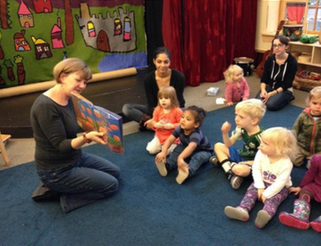65 Childcare
Martha Lally and Suzanne Valentine-French
About 71.6 percent of mothers of school-aged and 58.9 percent of mothers of preschool-aged children in the United States work outside the home (Bureau of Labor Statistics, 2015). Since more women have been entering the workplace, there has been a concern that families do not spend as much time with their children. This, however, is not true. Between 1981 and 1997, the amount of time that parents spent with children has increased overall (Sandberg and Hofferth, 2001).
To evaluate how early childcare affects children’s development, the National Institute of Child Health and Human Development (2006) conducted a longitudinal study. This study is considered the most comprehensive childcare study to date, and began in 1991 when the children were one month old. The study included an economically and ethnically diverse group of 1,364 children assessed from ten sites around the United States. By design the study involved single parents, minority backgrounds, and differing formal education levels. Childcare was defined as “any care provided on a regular basis by someone other than the child’s mother” (National Institute of Child Health and Human Development, 2006, p. 4). A “regular basis” included more than ten hours per week. Childcare arrangements included: care from the father or another relative; care from a caregiver not related to the child in the child’s home; small group care in the caregiver’s home; and centre-based care.
Overall results indicated that children cared for by their mothers did not develop differently than those who were cared for by others. Parents and family characteristics were stronger predictors of child development than childcare facilities. Specifically, greater cognitive, language, and social competence were demonstrated when parents were more educated, had higher incomes, and provided emotionally supportive and cognitively enriched home environments. When comparing higher quality childcare with lower quality childcare, differences were noted. Higher quality care, as measured by adult-to-child ratios, group size, and caregivers’ educational and training levels, resulted in higher cognitive performance, better language comprehension and production, and higher levels of school readiness. Lower quality care predicted more behavioural problems and poorer cognitive, language, and school readiness.

The higher the teacher-to-child ratio, the more time the teacher has for involvement with the children and the less stressed the teacher may be so that the interactions can be more relaxed, stimulating, and positive. The more children there are in a program, the less desirable the program. This is because the centre may be more rigid in rules and structure to accommodate the large number of children in the facility. The physical environment should be colourful, stimulating, clean, and safe. The philosophy of the organization and the curriculum available should be child-centred, positive, and stimulating. Providers should be trained in early childhood education as well. A majority of US states do not require training for their childcare providers. While formal education is not required for a person to provide a warm, loving relationship to a child, knowledge of a child’s development is useful for addressing their social, emotional, and cognitive needs in an effective way.
By working toward improving the quality of childcare and increasing family-friendly workplace policies, such as more flexible scheduling and childcare facilities at places of employment, we can accommodate families with smaller children and relieve parents of the stress sometimes associated with managing work and family life.

